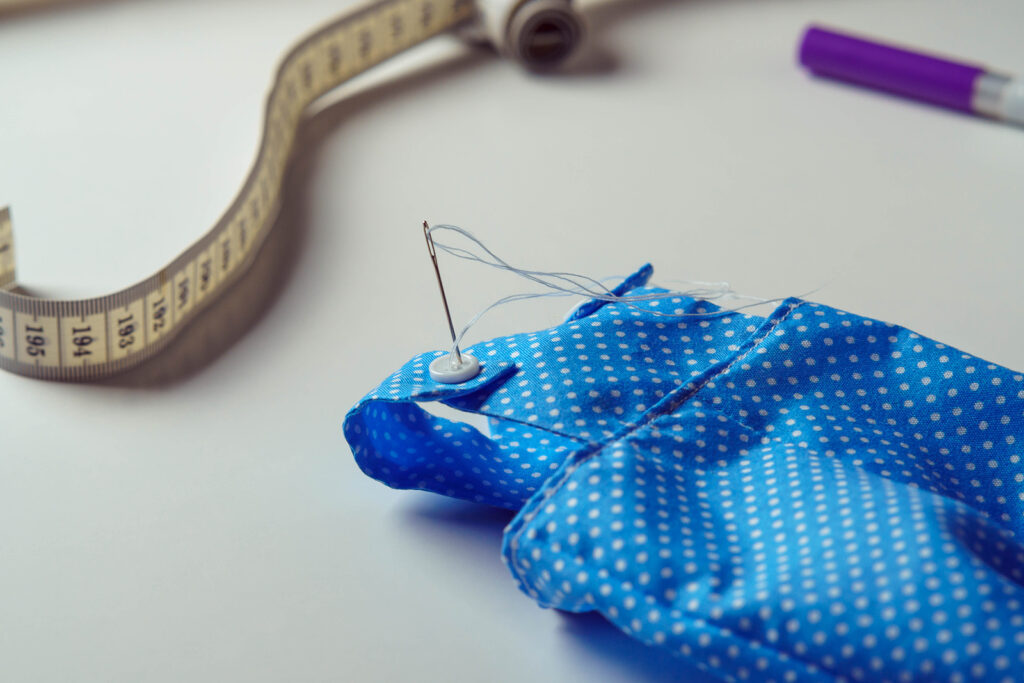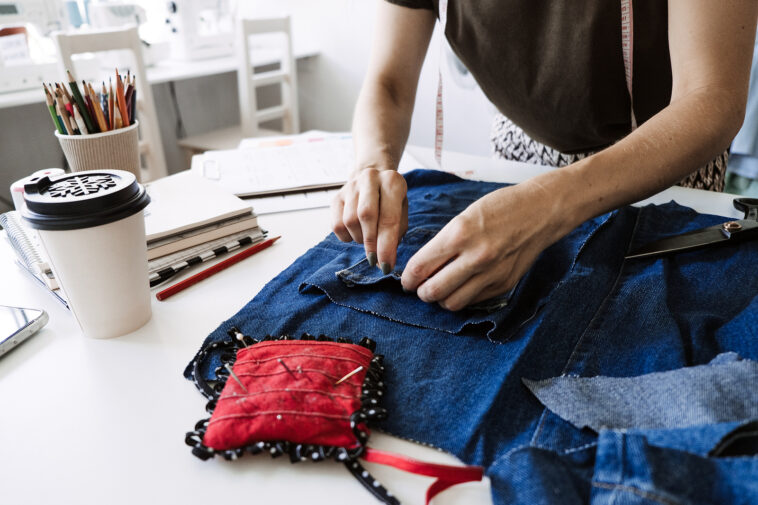DIY Clothes
As someone who loves fashion but is increasingly concerned about its rapid turnover and the environmental impact of the industry, I've found a sustainable and creative solution right at my fingertips: DIY clothes. In my journey to keep up with the latest styles while staying eco-conscious, I've discovered the joy of transforming my wardrobe with simple tweaks and DIY projects. Not only does this approach allow me to revamp my style on a budget, but it also reduces waste and provides a canvas for expressing my unique creativity.
Why Choose DIY Clothes?
In today's digital era, the popularity of do-it-yourself (DIY) clothing projects has surged, driven by several compelling reasons:
Sustainability Matters
The fashion industry, known for its fast-paced trends, has a substantial impact on textile waste and environmental degradation. By engaging in DIY clothing, you become part of the solution. You can select eco-friendly fabrics, repurpose old garments, and minimize waste, thereby reducing your carbon footprint and contributing positively to the planet's health. DIY clothing promotes a more sustainable approach to fashion.
Unique Style Statement
DIY clothing empowers you to express your individuality and creativity. It's a chance to design and craft garments that reflect your personality, tastes, and unique flair. Instead of conforming to mass-produced fashion, you can stand out in a crowd with custom-made pieces that embody your personal style. Each creation becomes a statement of who you are and what you represent.
Budget-Friendly
Contrary to the misconception that fashion can be an expensive hobby, DIY clothing is often a more budget-friendly option. Creating your clothing allows you to make the most of your resources, transforming old or thrifted items into trendy, personalized pieces without breaking the bank. You can choose fabrics and materials that suit your budget, all while honing your sewing and design skills.
Ethical Considerations
DIY clothing aligns with ethical principles by reducing your reliance on sweatshop labor and promoting fair labor practices. You have full control over the conditions in which your clothes are made, ensuring that your creations are produced ethically and in alignment with your values.
Empowerment and Skill Development
Engaging in DIY clothing projects can be a fulfilling and empowering experience. It allows you to acquire new skills, from sewing and pattern-making to fashion design. This hands-on learning process not only enhances your creativity but also boosts your self-confidence as you see your ideas come to life.

Essential Tools and Materials
Embarking on a journey into the world of DIY clothing is an exciting endeavor, but it's essential to have the right tools and materials at your disposal for successful and satisfying creations. Here's an in-depth list of what you'll need:
- Sewing Machine: Investing in a good-quality sewing machine is a cornerstone for your DIY clothing projects. It not only speeds up the sewing process but also ensures that your garments have a polished, professional finish. Consider factors like stitch variety and ease of use when selecting the right sewing machine for your needs.
- Basic Sewing Kit: A basic sewing kit is your trusty sidekick. It should contain a variety of essential tools and supplies, including:
- Needles: Different sizes and types for various fabrics and stitches.
- Thread: A range of colors to match your fabric choices.
- Scissors: Sharp, fabric-specific scissors for cutting with precision.
- Pins: To hold fabric pieces together securely.
- Measuring Tape: For accurate measurements and pattern adjustments.
- Fabric Chalk: Ideal for marking fabric without leaving permanent traces.
- Fabric: Your choice of fabric is crucial and can greatly influence the outcome of your DIY clothing. Some popular options for beginners include:
- Cotton: Versatile and easy to work with, suitable for a wide range of projects.
- Denim: Sturdy and durable, perfect for jeans, jackets, and accessories.
- Jersey: Stretchy and comfortable, ideal for T-shirts and casual wear.
- Silk: Elegant and lightweight, suitable for dresses and formal wear.
- Linen: Breathable and natural, great for warm-weather garments.
- Embellishments: Adding embellishments can elevate your DIY clothes to the next level. Gather a variety of options, such as:
- Buttons: In different shapes, sizes, and materials.
- Ribbons: For decorative accents or trims.
- Sequins: To add sparkle and glamour.
- Patches: Fun and trendy additions for personalization.
- Patterns and Templates: Whether you're altering existing clothing or starting from scratch, patterns and templates are invaluable tools. They provide precise guidance for cutting fabric and stitching seams. You can find patterns for various garments, such as dresses, tops, pants, and accessories, either in physical or digital form. Additionally, you can create your own patterns based on your unique designs.
Beginner-Friendly DIY Clothing Projects
If you're new to the world of DIY clothing, embarking on simple projects is the perfect way to begin your creative journey. Here's a more detailed look at some beginner-friendly ideas to ignite your passion for crafting your own garments:
T-shirt Upcycling
Start with a classic wardrobe staple—the plain t-shirt. Transform it into a fashion statement by turning it into trendy crop tops, off-shoulder tops, or muscle tees. Experiment with various cutting techniques to achieve your desired look. To add a personal touch, consider embellishing your revamped tees with unique prints, hand-painted designs, or custom slogans. This project not only breathes new life into old tees but also allows you to showcase your creativity.
Denim Revamp
Reviving old jeans can be a rewarding project. Instead of discarding worn-out denim, give it a second life. Experiment with distressing techniques to achieve a fashionable, lived-in look. Add patches or embroidery to breathe fresh style into your jeans. Alternatively, turn a pair of old jeans into stylish cutoff shorts that are perfect for summer. Denim revamping is an eco-friendly way to update your wardrobe while embracing sustainable fashion practices.
Customized Accessories
Elevate your DIY game by creating personalized accessories that complement your outfits. Craft your own scarves, headbands, or belts. Select fabrics that resonate with your style and colors that enhance your overall look. Adding embellishments, like beads, buttons, or embroidery, can transform these accessories into unique, statement pieces that showcase your fashion sensibilities.
No-Sew Projects
If you're a bit hesitant about sewing, don't worry! There are plenty of no-sew techniques that yield impressive results. Explore options such as fabric glue, iron-on patches, or adhesive studs to assemble your creations. These techniques are ideal for beginners and offer a wide range of possibilities for customizing your clothing and accessories without the need for a sewing machine.
Intermediate DIY Clothing Projects
Dressmaking
Venture into the world of dressmaking, where you'll create dresses, skirts, jumpsuits, or other garments from scratch using sewing patterns. This advanced DIY project allows you to select fabrics, tailor the fit, and experiment with various styles.
Mastering dressmaking opens up endless possibilities for crafting clothing that matches your unique vision and measurements, making it the pinnacle of personalization in fashion design.
Tailoring
Dive into the art of tailoring, which involves altering the fit of clothing to achieve a customized look. Learn essential tailoring techniques such as hemming (shortening or lengthening), taking in (making garments smaller), and letting out (making garments larger).
These skills are invaluable for achieving a perfect fit in your existing wardrobe, transforming thrifted finds, or creating custom-tailored pieces that exude style and sophistication.
Embroidery and Appliqué
Elevate your garments to wearable works of art by mastering intricate embroidery or appliqué designs. Whether you choose to adorn jackets, jeans, bags, or any clothing item, these techniques allow you to infuse your personal style with artistic flair.
Explore various embroidery stitches, from basic to advanced, such as crewel or satin stitch. Appliqué involves attaching fabric cutouts onto your clothing, creating a textured, eye-catching effect that sets your garments apart as unique and expressive pieces of fashion.
Upcycled Denim Jackets
Give ordinary denim jackets a fresh lease on life through creative upcycling. Experiment with techniques like fabric painting, distressing, patchwork, or the addition of studs to transform your denim outerwear into personalized statement pieces that reflect your style and personality. Upcycling is not only eco-friendly but also an opportunity to breathe new life into old favorites.
Knitwear Creations
Explore the world of knitting or crocheting to craft your own cozy sweaters, cardigans, scarves, or beanies. Handcrafted knitwear offers the perfect blend of warmth and style, allowing you to create fashion pieces that are not only functional but also deeply personal. Experiment with different yarns, stitches, and patterns to achieve the desired texture and look.
Advanced Sewing Techniques
Take your sewing skills to the next level by mastering advanced techniques such as sewing darts, pleats, gathers, and zippers. These skills are essential for tackling more intricate sewing projects and achieving a polished and tailored finish on your garments.
Custom Printed Fabrics
Elevate your DIY clothing by designing your own fabrics. Explore techniques like block printing, screen printing, or hand-painting patterns onto plain fabric. Custom printed textiles add a unique and artistic touch to your creations, allowing you to craft one-of-a-kind clothing items that stand out in the crowd.
Leatherwork
Dive into leather crafting to make stylish accessories like belts, wallets, or even leather jackets. Learn skills such as cutting, stitching, and embossing to create durable and fashionable leather pieces that are sure to impress.
Lingerie and Intimates
Challenge yourself by creating your own lingerie, bras, panties, or sleepwear. This advanced project involves exploring techniques like lace insertion, elastic application, and underwire construction, providing a deeper understanding of intricate garment construction.
Advanced DIY Clothing Projects
For those DIY enthusiasts who've mastered the basics and are ready for a greater challenge, advanced projects await. These endeavors will not only test your skills but also allow you to create exquisite, tailored pieces of clothing. Here's an in-depth look at some advanced DIY clothing projects:
- Bespoke Suits and Coats: Step into the world of precision tailoring by crafting bespoke suits, blazers, or overcoats. This advanced project demands mastery of intricate techniques such as lining, interfacing, and creating flawless buttonholes. You'll delve into the nuances of fitting, fabric selection, and pattern drafting to ensure that your tailored garments fit you like a glove. Bespoke suits and coats are timeless investments that reflect both craftsmanship and personal style, making them the ultimate DIY challenge for the fashion-savvy.
- Corsetry: Explore the intricate art of corset making, where you'll design pieces that not only enhance your figure but can also serve as striking outerwear or intimate lingerie. Corsetry involves precise pattern drafting, boning insertion, and intricate lacework or embroidery. These garments require meticulous attention to detail, as they must be comfortable, supportive, and aesthetically pleasing. Crafting a corset allows you to combine fashion, art, and body contouring into a single, captivating creation.
- Leatherwork: Immerse yourself in the world of leather crafting, where you'll fashion belts, bags, or even shoes from scratch. Working with leather introduces you to various types of leather and specialized tools, including leather cutters, punches, and edge finishers. You'll learn techniques such as stitching, dyeing, and tooling to create durable and stylish leather accessories or footwear. Leatherwork is a versatile and rewarding skill that opens doors to endless possibilities for customization and personalization.
- Advanced Knitwear: Elevate your knitting and crocheting skills by taking on intricate and complex knitwear projects. Craft intricate lace shawls, cable-knit sweaters, or multi-color Fair Isle patterns. These advanced techniques require a deep understanding of stitch patterns, gauge, and shaping, resulting in garments that are both visually stunning and technically impressive.
- Couture Techniques: Embrace the art of haute couture by exploring advanced couture sewing techniques. This includes techniques like hand-stitching, draping, and constructing garments with meticulous attention to detail. You'll learn to work with luxurious fabrics, apply intricate embellishments, and create clothing that's a testament to your commitment to craftsmanship and elegance.
- Wedding and Evening Gowns: Design and create exquisite wedding dresses or evening gowns that are tailor-made to your specifications. These projects encompass intricate construction, intricate beading or embroidery, and attention to the finest details. Crafting a gown of this caliber allows you to blend fashion design with personal sentiment, resulting in a masterpiece that holds a special place in your heart.
DIY Clothes for Special Occasions
DIY clothing isn't confined to everyday wear; it's a versatile avenue for creating remarkable outfits tailor-made for special occasions. Whether you're envisioning a personalized wedding ensemble, elaborate costumes for cosplay, or eye-catching festival and party wear, the world of DIY fashion opens up a realm of possibilities:
Wedding Attire
Make your wedding day truly unforgettable by designing your wedding gown, bridesmaid dresses, or even the groom's attire. Crafting your wedding attire allows you to infuse your personal style and sentiments into these once-in-a-lifetime garments. You can choose fabrics, silhouettes, and embellishments that resonate with your vision, ensuring that every detail reflects the essence of your love story. These custom creations become cherished heirlooms and symbolize your commitment to each other.
Cosplay and Costumes
Dive into the art of cosplay and costume-making, where the only limit is your imagination. Whether it's for conventions, Halloween, or themed parties, crafting intricate costumes allows you to transform into your favorite characters or bring your creative visions to life. From meticulously sewing superhero suits to sculpting fantasy armor, these projects test your skills and artistic abilities. You'll learn to work with various materials, experiment with makeup and props, and create stunning ensembles that capture the essence of the characters you admire.
Festival and Party Wear
Be the center of attention at music festivals, themed parties, or any festive gathering with DIY clothes that exude personality and vibrancy. Embrace bold colors, sequins, and eye-catching designs to craft outfits that radiate energy and creativity. From bedazzled bodysuits to hand-painted jackets, your festival and party wear can reflect your unique style and set you apart in any crowd. These DIY creations are an opportunity to express your individuality and make a lasting impression at every event.
Prom and Formalwear
Elevate your prom or formal event experience by designing and creating your own prom dress or formalwear. This project allows you to stand out with a one-of-a-kind outfit that perfectly matches your taste and body type. You can explore luxurious fabrics, elegant silhouettes, and exquisite embellishments to make your attire truly special for these memorable occasions.
Holiday and Theme-Specific Outfits
Embrace the festive spirit by crafting holiday-themed or theme-specific outfits. Whether it's a unique Christmas sweater, a costume for a themed cruise, or matching family outfits for a holiday photoshoot, DIY clothing adds a personal and creative touch to seasonal celebrations and special events.

Maintaining and Storing DIY Clothes
Creating DIY clothes is a labor of love, and preserving the beauty and longevity of your handmade garments is crucial. To ensure your creations remain in pristine condition, consider these comprehensive tips for washing, cleaning, and storing DIY clothes:
Washing and Cleaning:
- Fabric Knowledge: Begin by understanding the fabric types used in your DIY garments. Different fabrics have distinct care requirements. Some may be machine-washable, while others demand delicate handling. Read and follow the care instructions provided with the fabric or pattern to prevent damage.
- Handwashing: For delicate or handcrafted pieces, consider handwashing as the gentlest method of cleaning. Use a mild detergent and lukewarm water, and avoid wringing or twisting the fabric, as this can cause stretching or distortion.
- Machine Washing: When machine-washing is suitable, turn your DIY clothes inside out to protect the outer surface from abrasion and fading. Select a gentle cycle with cold water, and use a laundry bag or pillowcase to shield delicate items from friction.
- Drying: Opt for air drying whenever possible. Lay your garments flat on a clean, dry towel to maintain their shape. Hanging items with straps or delicate fabrics can lead to stretching, so proceed with caution.
- Stain Removal: Address stains promptly, but exercise care. Blot rather than rub to prevent spreading the stain. Consider using stain-specific treatments, following the manufacturer's recommendations.
Storage Tips:
- Cool and Dry: Store your DIY clothes in a cool, dry location away from direct sunlight, which can cause fading. Avoid basements, attics, or damp areas, as moisture can promote mold and mildew growth.
- Garment Bags: Invest in breathable garment bags to protect your creations from dust and insects. Avoid plastic bags, as they can trap moisture and lead to mold growth. Ensure that the bags are clean and dry before use.
- Hanging vs. Folding: Hang items made from fabrics prone to stretching or losing shape, such as knits and delicate weaves, on padded or wooden hangers. Fold garments made of heavier fabrics or those prone to wrinkling, like cotton or linen. Use acid-free tissue paper to separate layers and prevent color transfer.
- Cedar Blocks: To deter moths and keep your DIY clothes smelling fresh, consider placing cedar blocks or sachets in your storage area. These natural repellents are effective and safe for fabrics.
- Regular Inspection: Periodically inspect your stored clothing for any signs of damage or pests. Early detection allows you to address issues promptly and prevent irreversible damage.
Conclusion
Through my personal journey with DIY clothing, I've come to realize that it's more than just a creative outlet; it's a profound way to connect with fashion on a deeper level. DIY clothing allows me to shape my wardrobe according to my unique style, values, and imagination. It's a journey of self-discovery, empowerment, and a commitment to sustainability.
Not only does it enable me to repurpose old garments and choose eco-friendly materials, but it also fosters a sense of achievement as I acquire new skills and create one-of-a-kind pieces. Ultimately, DIY clothing is a transformative experience that not only changes my wardrobe but also changes me, enriching my life with creativity, self-confidence, and a deeper connection to fashion and the world around me.
Sources:
https://www.nal.usda.gov/exhibits/ipd/apronsandkitchens/items/show/60




